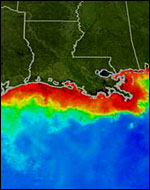U.S. farmers planted 92.9 million acres of corn this spring, a 15 percent-plus jump from last year. If you lumped all that land together — not too hard to imagine, given that corn ag is highly concentrated in the Midwest — you’d have a monocropped land mass nearly equal in size to the state of California.

The jump in corn acreage is excellent news if you own shares in mega meat-processing firms like Tyson and Smithfield. These firms have been complaining bitterly that the price of corn, driven up by the government-induced ethanol boom, will eat into their profits. (Corn is the preferred feed of CAFO operators, if not of the animals they confine.)
The California-sized corn planting is expected to deliver the largest corn harvest in U.S. history, which will likely drive corn prices down a little.
But the corn boom absolutely sucks if you live in a fishing community along the Gulf Coast — or if you happen to be a fish who makes a home in those troubled coastal waters.
Researchers projected [PDF] Monday that the Gulf of Mexico’s Dead Zone, like this year’s corn harvest, will likely be the largest ever recorded.
According to major ag policy-makers in D.C., farmers’ decisions to plant as much corn as possible — often on environmentally fragile land previously kept fallow for conservation purposes — was a farsighted and rational move.
The explosion in corn plantings "further confirms that production and usage of biofuels can boost farm income, economic growth and jobs in rural communities while enhancing America’s energy security," enthused Sen. Tom Harkin (D-Iowa), chair of the Senate ag committee.
The news drew similar raves at USDA headquarters. "It’s just incredible," gushed the agency’s chief economist Keith Collins. He added hopefully that the huge corn crop should "give livestock feeders some relief."
But while Tyson and Smithfield execs breathe easier, fishing communities along the Gulf Coast are bracing for disaster.
That’s because growing corn in vast monocultured fields requires heavy doses of synthetic nitrogen, but all of that fertilizer doesn’t end up in corn plants. A good bit of it washes into streams which feed into the Mississippi River, then to be carried clear down to the Gulf.
In a process known as hypoxia, all of that free nitrogen feeds a giant algae bloom, which ties up oxygen and destroys most life underneath: hence the "Dead Zone."
According to a report (linked above) by researchers R. Eugene Turner of LSU and Nancy Rabalais of the Louisiana University Marine Consortium, preliminary measures of nitrogen passing into the Gulf through the Mississippi, taken in May, augur the biggest Dead Zone ever recorded.
"Hypoxia as a large-scale phenomena was unlikely to have occurred before the 1970s," the researchers write. The Dead Zone’s emergence roughly coincides with the age when Earl "Rusty" Butz, Nixon’s ag czar, ruled the USDA with an iron fist. Butz famously used the power of his office to prod farmers to plant "fencerow to fencerow," with as much fertilizer as required to produce bumper crops. That policy has been in place ever since.
Thirty odd years later, we’re still allowing our government to sacrifice the Gulf’s biodiversity, along with the livelihoods of surrounding fishing communities, to produce dubious fuel and ghastly meat.
The mind reels.


